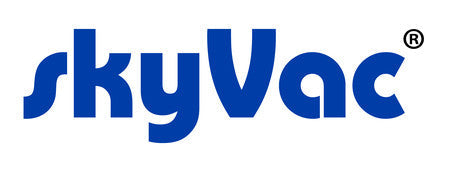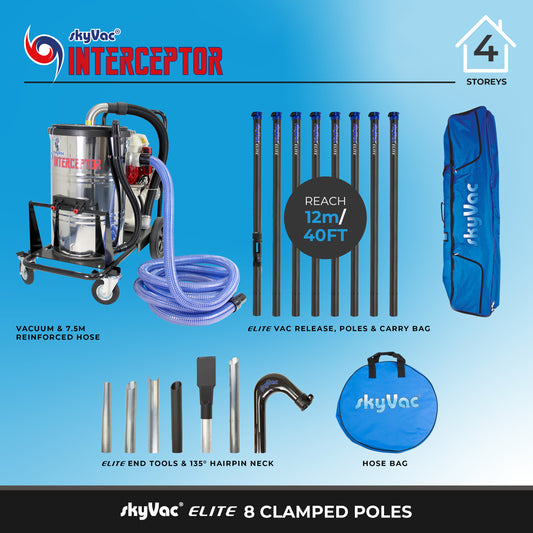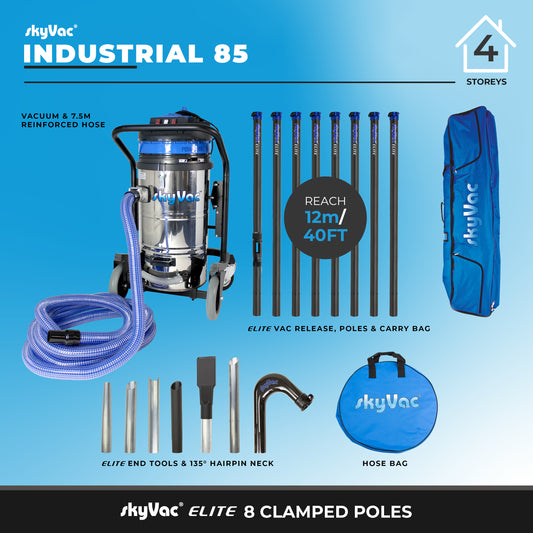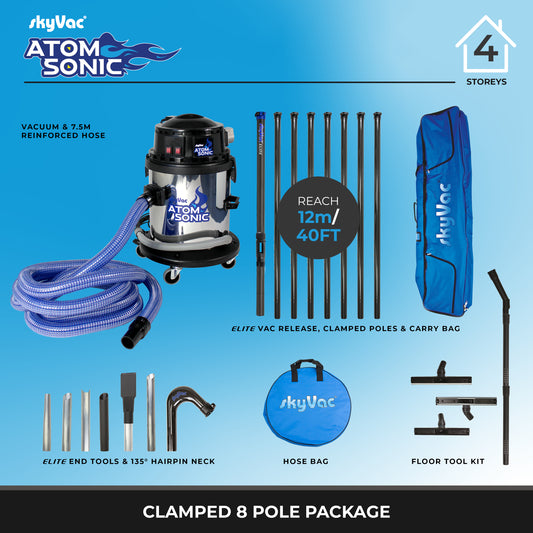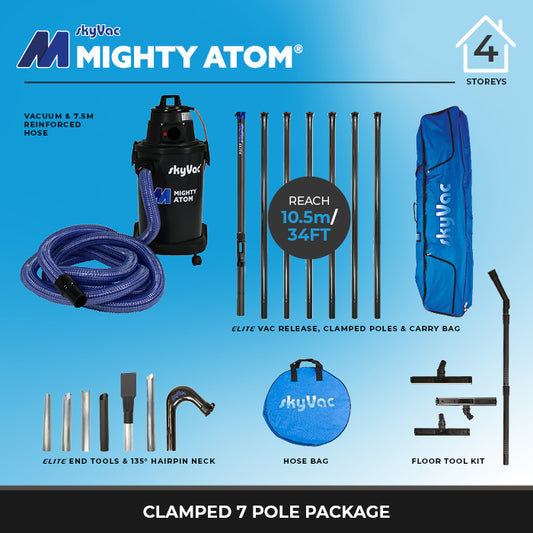Maximizing Cleanliness: A Comprehensive Guide to Commercial High Dusting Systems
Share
We’ve tackled plenty of dusty corners up high, and we’ve learned the hard way that you need the right gear. With Commercial High Dusting Systems, we can reach ceiling beams, ductwork, and light fixtures without climbing ladders or risking safety. It’s about cleaner air, fewer fire risks, and a workspace that looks sharp. In this guide, we’ll show why these systems matter, how we pick the right tools, and how we keep everything in good shape.
Key Takeaways
- We remove hidden dust from ceilings, beams, and ducts to keep the air fresh and cut fire hazards.
- We pick poles that give us reach, match our cleaning heads, and hook into HEPA vacuums for clean capture.
- We follow a top-down cleaning flow and inspect our poles and tools often to avoid breakdowns.
Why Commercial High Dusting Systems Matter
We often overlook the importance of maintaining cleanliness in those hard-to-reach, high-up areas of commercial spaces. But trust us, investing in commercial high dusting systems is a game-changer for several reasons. It's not just about appearances; it's about health, safety, and overall operational efficiency. Let's explore why these systems are so important.
Improving Air Quality And Allergen Control
Dust and allergens love to settle in high places. Think about it: ceilings, rafters, and ductwork are prime real estate for these unwanted particles. When left unchecked, this buildup can significantly impact indoor air quality. By regularly using high dusting systems, we can remove these irritants, creating a healthier environment for everyone. This is especially important for businesses that want to ensure the comfort and well-being of their employees and customers. Consider these points:
- Reducing allergens can lead to fewer allergy-related sick days.
- Cleaner air improves overall respiratory health.
- Regular dusting prevents the spread of dust mites and mold spores.
Maintaining good air quality is not just a nice-to-have; it's a necessity for a productive and healthy workspace. High dusting systems help us achieve this by targeting the areas where dust and allergens accumulate the most.
Reducing Fire Hazards And Facility Risks
Dust accumulation isn't just a health concern; it's also a serious fire hazard. Dust buildup on light fixtures, electrical conduits, and HVAC systems can act as fuel, increasing the risk of fire. Regular high dusting minimizes this risk, protecting our facilities and the people inside them. Here's why this is so important:
- Dust can insulate electrical components, causing them to overheat.
- Combustible dust, common in some industries, can ignite easily.
- Removing dust reduces the likelihood of electrical fires.
Using the right gutter vacuum systems, like the SkyVac, helps us maintain a safer environment by preventing dust-related hazards.
Selecting The Right Commercial High Dusting Systems
Choosing the correct high dusting system is important for effective and safe cleaning. We need to consider several factors to ensure we select a system that meets our specific needs. Let's explore the key aspects to consider when selecting a high dusting system.
Assessing Reach And Attachment Compatibility
When selecting a high dusting system, reach is a primary consideration. We need to assess the maximum height of the areas we intend to clean to ensure the system can reach those spots without the need for ladders or lifts.
Here's what we consider:
- Pole Length: Select poles that extend sufficiently to reach the highest points in our facility. Telescopic poles offer adjustable lengths for various tasks.
- Attachment Compatibility: Ensure the pole is compatible with a range of attachments, such as brushes, microfiber sleeves, and vacuum heads, to handle different surfaces and types of dust.
- Extension Options: Look for systems that offer extension pieces for added reach in particularly high or difficult-to-access areas.
It's important to consider the weight and maneuverability of the pole when fully extended. A lighter pole will reduce fatigue and improve control, especially during prolonged use. We should also check the locking mechanisms to ensure they are secure and prevent the pole from collapsing during operation.
Ensuring HEPA Vacuum Integration
Integrating a HEPA vacuum is important for effective dust removal and maintaining air quality. HEPA filters capture 99.97% of particles, including dust, allergens, and other irritants, preventing them from recirculating into the air.
Here's how we ensure proper HEPA vacuum integration:
- Compatibility: Verify that the high dusting attachments are compatible with HEPA vacuum systems. Look for attachments specifically designed for vacuum-assisted cleaning.
- Sealed Connections: Ensure all connections between the pole, attachments, and vacuum hose are tightly sealed to prevent dust leakage. This maximizes the effectiveness of the HEPA filter.
- Vacuum Power: Choose a vacuum with sufficient suction power to effectively remove dust and debris from high surfaces. Consider models like the SkyVac 30, known for its commercial-grade performance.
By carefully assessing reach, attachment compatibility, and HEPA vacuum integration, we can select a high dusting system that meets our cleaning needs and promotes a healthier indoor environment.
Implementing Best Practices For High Level Dusting
As we move into the practical aspects of high dusting, it's important to establish some best practices. This will not only make the job easier but also ensure a thorough and safe cleaning process. Let's explore some key strategies to maximize the effectiveness of your high dusting systems.
Top To Bottom Cleaning Sequence
When it comes to high dusting, the order in which you clean is crucial. Always start from the highest points in the room and work your way down. This prevents dust and debris from falling onto already cleaned surfaces, saving you time and effort. Think of it like this: you don't want to clean the floor before you dust the ceiling, right?
- Begin with ceilings, rafters, and overhead pipes.
- Move to light fixtures and high shelves.
- Finish with walls and floors.
By following this sequence, we minimize the risk of re-contaminating surfaces and ensure a more efficient cleaning process. This approach also helps maintain better air quality during and after the cleaning.
Maintaining And Inspecting Equipment
Our equipment is only as good as the care we give it. Regular maintenance and inspection are vital for ensuring the longevity and effectiveness of our high dusting tools. This includes everything from the extension poles to the vacuum attachments. A well-maintained system not only performs better but also reduces the risk of accidents or equipment failure.
- Regularly check poles for damage or wear.
- Clean or replace filters in vacuum systems.
- Inspect attachments for proper function and cleanliness.
- Ensure all connections are secure before each use.
# Conclusion
We've covered why dusting high places counts, from cleaner air to fewer fire risks. We showed how extendable poles, HEPA vacuum heads, and simple brushes from SkyVac and Clean Direct help us work safely from the floor. We walked through a clear plan: start at the top, move down, rinse or swap your sleeves, and check your gear each time. It takes a bit of practice. But once we find our groove, dusty rafters and ductwork don't stand a chance. In the end, we get a tidier space and a lighter to-do list.
Frequently Asked Questions
Why do we need commercial high dusting systems?
We use these systems to reach and clean high spots that regular tools can’t touch. By doing full dust removal up top, we make our air healthier and cut down on fire risks. It also keeps our building looking neat and up to code.
How do we choose the right high dusting system?
First, we check how high we need to clean and pick a pole that can extend far enough. Then we make sure it works with our vacuum, especially one with a HEPA filter. That way, we catch dust safely without letting it blow back.
What is our best way to do high level dusting safely?
We always start cleaning from the highest point and work down so we don’t spread dust back up. We inspect our poles and attachments before each job. And we keep tools clean after use to make sure they last and work well next time.
